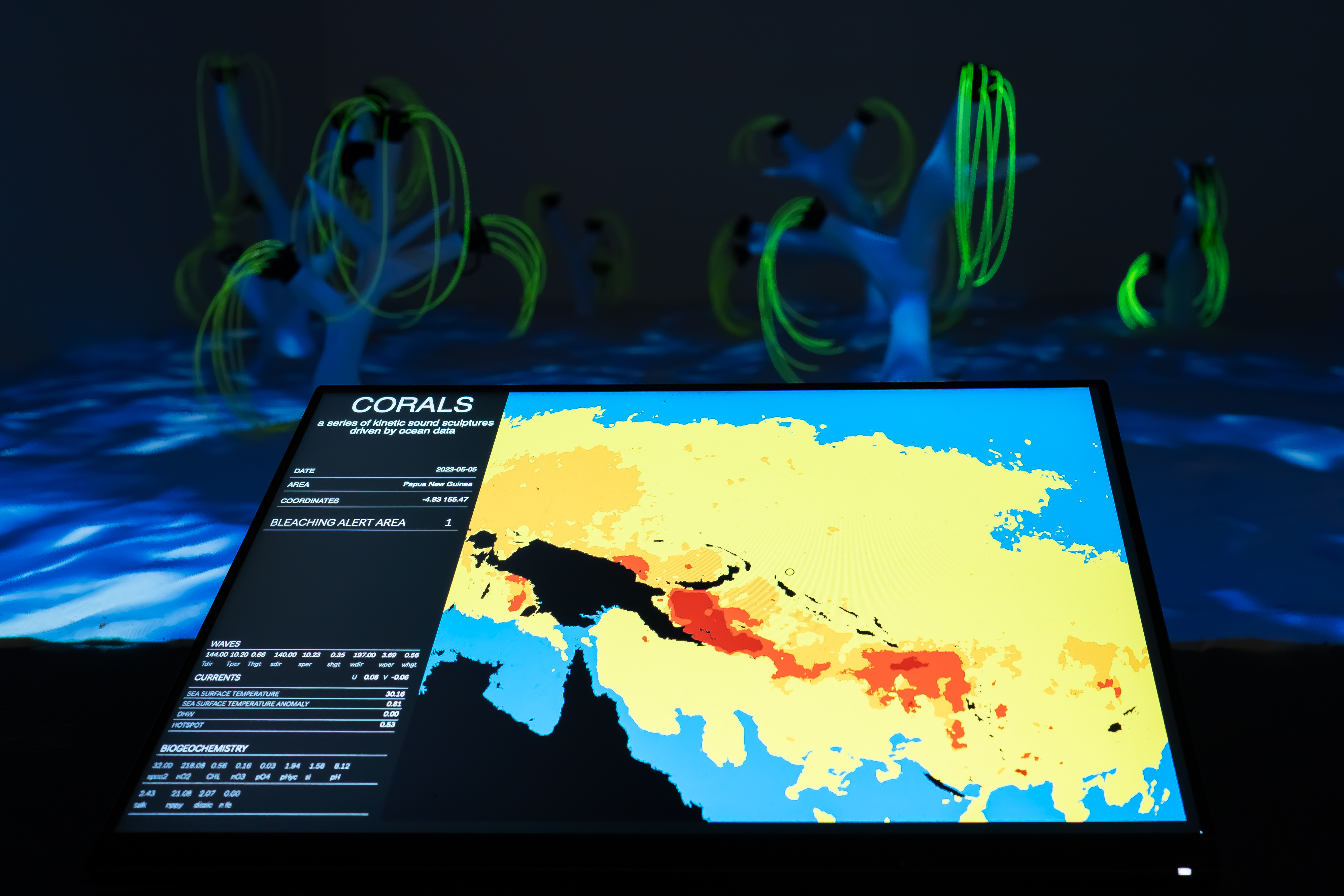CORALS







CORALS raises awareness about the precarious situation of coral reefs and the urgent need to establish a harmonious relationship with the underwater world. The installation features kinetic sound sculptures that resemble branch corals in an immersive underwater environment. Real-time data on ocean conditions and coral bleaching alert areas are visualized on a monitor, while the very same data feed into machine learning models to modulate sound, visuals, and movement of the installation.
The series of 3D-printed sculptures were developed as visual reference to coral reefs based on 3D scans provided by researchers at the Earth Observatory of Singapore. These sculptures are embedded in soundscapes, movement, visuals, and lighting generated by machine learning models. The audio elements combine the sounds of healthy coral reefs and recordings of shamanistic music from around the world, transforming CORALS into a „Techno Shaman.“ The shamanistic music ranges from singings to the oceans, healing rituals, to death rituals.
The data that drives this metaphorical “Techno Shaman” comes from Bleaching Alert Areas (BAA) and is provided by NOAA Coral Reef Watch, NASA and Copernicus. It is comprised of sea surface temperatures, anomalies, waves, currents, and biological data. The system randomly selects a coral reef location and displays its situation at the selected time. Depending on the particular level of coral bleaching at the selected location, the machine learning model creates the specific "atmosphere" of the installation. Different aspects of the BAA data such as waves, currents, and sea surface temperature modulate the dynamics and pitch of the sound, movements of the sculptures, and dynamics in the lighting systems and visuals. The biological data interacts with various sound effects, which enhances the evolving soundscapes and creates more variations within the sonic experience.
CORALS represents the fragile marine ecosystem and the impact of coral bleaching. Environmental stress disrupts the symbiotic relationship between corals and their symbionts, resulting in coral bleaching and starvation. Coral bleaching damages biodiversity, which in turn affects human social and economic systems. Interestingly, scientists found that the sound of healthy coral reefs in destroyed ecosystems lures back fish communities and helps restoration. CORALS fuses this poetically with positive human action. Recognizing the human role as both part of the problem and part of the ecosystem, we must actively pursue positive change. By combining art, technology, and global cultural traditions, CORALS attempts to inspire positive action and preserve the fragile beauty of coral reefs.
CORALS by Marco Barotti, was created during the residency “Kunst der Verschränkung” at the Berlin Institute for the Foundations of Learning and Data (BIFOLD), in collaboration with the Science Gallery Berlin at the Technische Universität Berlin, with additional support by NEUSTARTplus-Stipendiums der Stiftung Kunstfonds.
Credits
CORALS by Marco Barotti, was created during the residency “Kunst der Verschränkung” at BIFOLD, in collaboration with the Science Gallery Berlin at the Technische Universität Berlin
Curator Claudia Schnugg
Software programming Marco Accardi / Anecoica Studio, Victor Saiz
AI and machine learning experts Federico Visi, Oliver Eberle, Christopher Anders
Design Cora Röschlein, Francesco Zedde, Boban Zivanovic, Jonathan Wellmann
Visuals Tatsuru Arai
Lights Malte Kebbel
Audio and programming assistant Misha Douglas MacLaren
Music rituals Eunmi Pang, Percy Garcia, Haenyeo of Jeju Island
Strategic writing Sarah Möller
External eye Marco Canevacci, Pihla Pellinen
Technical advisor Benjamin Maus
Data source NOAA Coral Reef Watch, Nasa, Copernicus
Data contributor Erick Geiger, NOAA Coral Reef Watch Scientist
Coral research St. John's Island National Marine Laboratory, Tropical Marine Science Institute,
National University of Singapore, The Coral Team: Jani Tanzil, Lionel Ng, Shaun Wee, Leong Wai, Ow Yong Wei Long, Jonas Khaw
Corals research Danwei Huang, Lee Kong Chian Natural History Museum, National University of Singapore
Corals research Antonio Beggiato, Coral Restoration Project Feridhoo
Corals research and 3D scanning Kyle Morgan, Earth Observatory of Singapore, Nanyang Technological University
Corals sound research Too Yuen Min, Hari Vishnu, Mandar Chitre, Acoustic Research Laboratory, National University Of Singapore.
Corals sound research Dr Timothy Lamont, Lancaster University
Tech partner Ambient Recording
Video Tobias Rosenberg
Tech Partner Adam Audio
Funded by BIFOLD Kunst der Verschränkung Residency 2022/23, and Stiftung Kunstfonds, Neustart Kultur Plus Stipendium.
Supported by the Directorate-General for Contemporary Creativity of the Italian Ministry of Culture under the Italian Council program (2023).
Residency support and local production, Katharina Jung, Kerstin Wagner, Michael Fowler, Jean-Paul Olivier, Manon Grube, Annette Müller, Robert Niemann
Thanks to BIFOLD ´Tom Burgert, Kirill Bykov, Panagiotis Agrafiotis, Begüm Demir, Volker Markl, Klaus-Robert Müller
Thanks to Claudia Fleck and Adrian Sieler at TU Berlin
Special thanx to Gianluca Malgeri, Tokyo Biennale, Anna Anderegg, Roibu Irina, Margherita Albanese, Under The Sea Jeju, ki bong Kim, Sunmin Hwang, Jongmin Kim, Toms Korallen, Zihern Shooyong Lee, Keumhwa Kim, Nayun Lee, Tokyo Biennale, Mattia Tuliozi